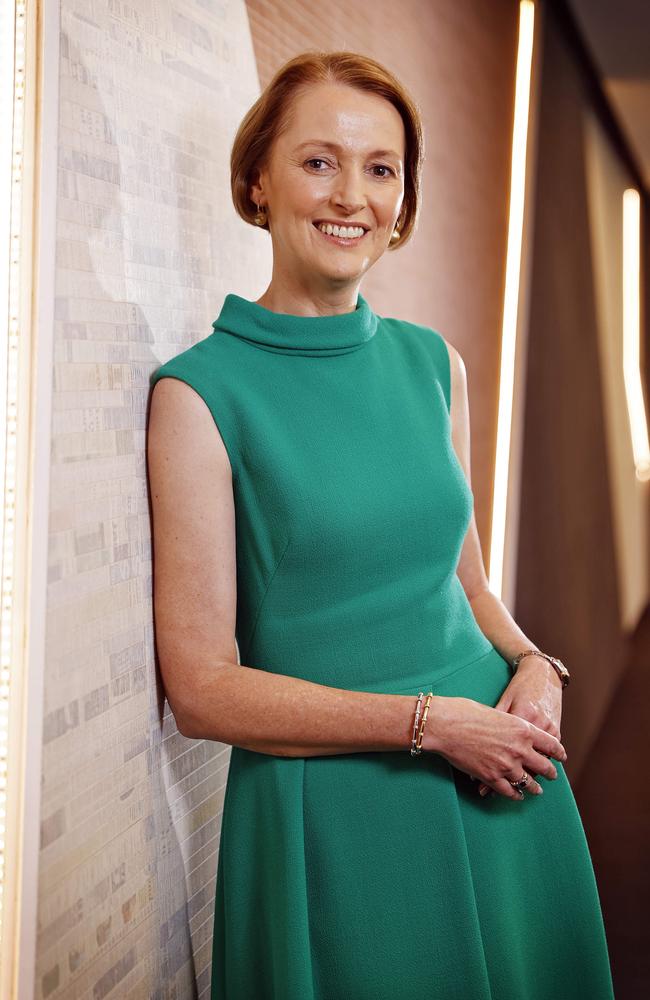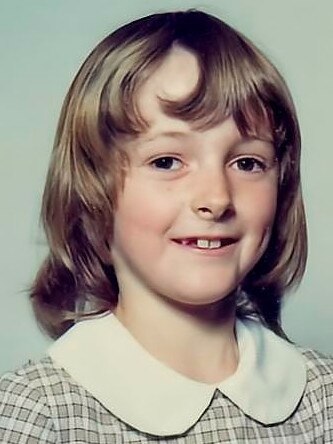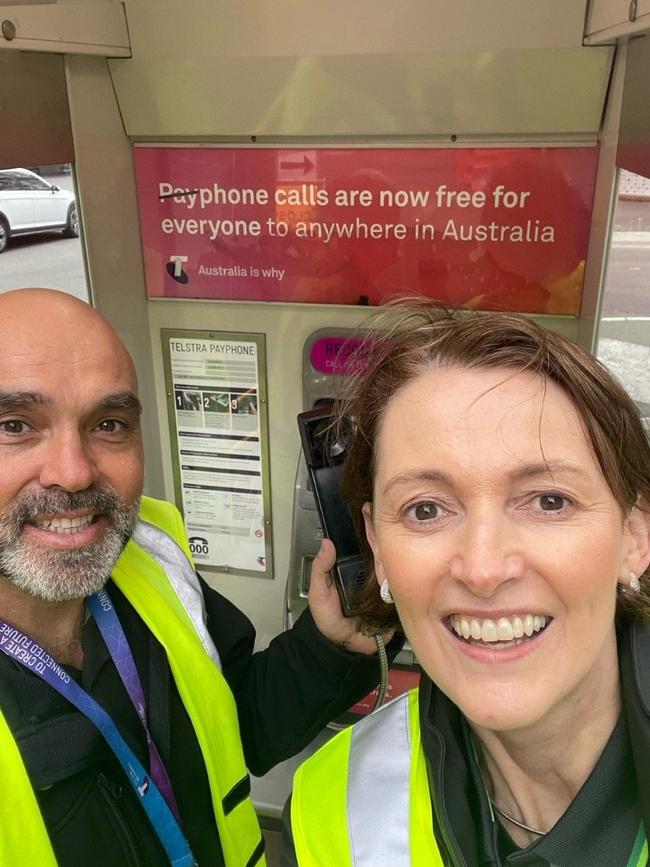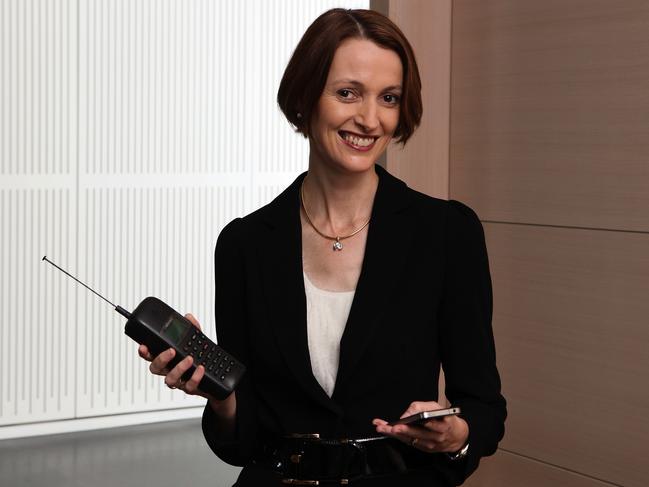Telstra chief executive Vicki Brady reveals cancer battle
Vicki Brady is now running Australia’s biggest telco, but there were questions whether she would even return to work.
Companies
Don't miss out on the headlines from Companies. Followed categories will be added to My News.
When Vicki Brady told her father Terry on a FaceTime call that she was about to be appointed chief executive of Telstra, he took a deep breath.
Just a few years earlier, Brady had been battling cancer and there were questions whether she would go back to work at all, let alone take on such a demanding job.
The 51-year-old had grown up helping her dad run the “middle pub” in Holbrook, a town of 2000 people on the Hume Highway, five hours south of Sydney.
The top pub was still open, the bottom had long closed but the Riverina Hotel, which the family ran, was still the “middle pub”.
For her dad, who has retired to the Gold Coast, the idea of his daughter running Telstra, a $45bn-plus company, was extraordinary.

Now, in her first major interview since taking on the chief executive role, as Brady sits in a side room near her office on level 30 of the Telstra tower in George St, Sydney, her face beams as she retells the story of her father’s reaction.
“We did a FaceTime call. I was there with my husband and two daughters and said: ‘Dad, just want to let you know some news. It will be announced tomorrow, I’m going to be the next CEO of Telstra’,” she says.
“And he takes this deep breath and he goes: ‘Fair dinkum’.
“My two daughters were like: ‘What does fair dinkum mean? I’ve not heard that expression before’. It was one of those moments.”
To many in Telstra, Brady’s appointment as chief executive was far from a shock after her performance as chief financial officer.
Andy Penn had been in the top job at Telstra for more than seven years until Brady took over in September 2022.
He had overseen a major transformation – that’s business speak for cutting 8000 jobs – to slash $2.5bn in annual costs out of the company.

The types of phone plans the company sold was cut from 1800 to 20.
Penn was the face of Telstra but far less controversial than former chief executive Sol Trujillo, who was rarely off the front pages prior to his resignation in 2009.
David Thodey took the reins for six years, before Penn was appointed in 2015.
Many at Telstra, including Penn, were worried about Brady when she was battling breast cancer. The 2018 diagnosis kept her out of work for 10 months.
“I went to the doctor, something felt unusual. Next morning I was in for tests and by lunchtime I was told that I had breast cancer and I was going to need to step out and
go through pretty extensive treatment,” Brady says.
“My world just changed in an instant.”
Her husband Mark was with her when she received the bombshell news. And then they had to tell their daughters.
“I had chemotherapy first for a number of months and then had surgery,” Brady says.
“I guess when you face your own mortality,
it changes things. You go, okay, I need to step out of work because I can’t be my best there at this time.
“And I certainly need to give everything to getting myself better.”
There was no pressure on Brady to return to work in a hurry, or at all.
Penn, who was Melbourne-based, dropped in on Brady in Sydney when she was ill.
“Andy came and visited me at home. One of his first questions was: ‘So, has it changed your view? Do you want to still be in an executive role? Has it changed any of your priorities?’
“There’s no doubt it (cancer) put a whole different lens on my health and how I look after myself, it enhances that lens around family and how important that is.
“But equally, I came out of it going, actually being in an organisation and having a chance to lead teams and be a part of doing things that bring out the best in them and deliver for customers and communities – that was absolutely still a priority for me.
“I wanted to do it, through that period it was part of me that I really missed.
“I said: ‘Yes, I definitely want to come back’.”
Brady had a four-year check up in the same month as she took on her new job.
The results were clear. Another step forward.
LESSONS LEARNED IN THE RIVERINA PUB
Meeting her in her office, flanked by two ofhersenior communications colleagues around a circular wooden desk, with large windows overlooking the Sydney skyline, you would have more chance of picking a 100 to 1 winner in the Melbourne Cup than guessing that Brady has battled cancer.
Her health has something to do with her 5.30am starts, heading to the gym two or three times a week.
Running Telstra is one of the biggest corporate jobs in Australia, on par with Qantas, which has been led by Alan Joyce since 2008.
Telstra, like Qantas, was once government-owned. The company was formed out of the old Telecom, with many Australians buying their first private shares when then prime minister John Howard floated the phone company in 1997.
The shares debuted at $2.60, quickly climbed to more than $7 in 1999 but then spent a decade in a downward spiral.
The company hit $6 in 2015 but then plummeted again and has now begun rebuilding, trading around the $4 mark during the first week of December this year.
More than 1 million Australians still own Telstra shares directly, while many would own some slice of the company through their superannuation funds.
Everyone has a view of Telstra – about what it was and what they want it to be.
A colleague pointed out that Trujillo wanted Telstra to be sexy – but it really needs
to be boring.


The company has a place in the nation’s heart like Australia Post – and for people in regional and rural areas, a Telstra plan is a necessity, rather than a luxury, because it often is the only carrier providing a reliable service.
Brady looks assured when talking about the challenge of taking on the chief executive role for such an organisation.
She says she doesn’t have the share price stuck on her computer screen, like some other chiefs – in the C-suite – at other major companies.
Some of the lessons learned in The Riverina Hotel in Holbrook have been taken into the Telstra tower.
“In a pub like that, you’ve got lots of locals. You’re part of the community, sponsoring sporting clubs,” she says.
“What I loved about growing up in a small town is the community aspect. It’s very close-knit, everyone kind of knows everyone and seeing dad run a small business … that’s what actually led me to wanting to be in business.”
Like the “middle pub”, Brady’s company sponsors sporting clubs, although on a slightly larger scale with Telstra’s involvement with the AFL and the NRL.
For the record, in the AFL and AFLW, she follows the Richmond Tigers and in the NRL and NRLW, she’s a Manly Sea Eagles fan.
“I’m a real believer that when you run whatever size business, there’s real fundamentals of business,” Brady says.
“In a small business, you are very focused on the cash that comes in the door.
“You’ve got to be able to pay salaries, you’ve got to manage inventory.
“You’ve got to have good people working with you, so you can build that trust.
“And so lots of those fundamentals, obviously Telstra’s a very big business, but again running a business, those foundational pieces need to be right.
“There’s things I’ve taken away from there (The Riverina Hotel). It was very much a community and the customers, you built relationships with them.
“And that’s why through my career in business, I’ve loved the customer side of it. It took me a little while to figure that out because I started in finance and accounting.”

A concrete example of putting customers first was Telstra’s move to take back control of
its stores.
Previously, the company handed about half of them over to franchisees, but now the 300 stores across the country are under the direction of headquarters.
Call centres are also in Australia.
The company has also been doing something very important that no one has been able to notice – repelling hacking attacks.
When we spoke in Brady’s office, there had been weeks of reports about data stolen from Optus customers.
Prime Minister Anthony Albanese demanded Optus pay for any replacement passports required for the 10 million customers who had their details compromised in a sophisticated cyber raid.
Health fund Medibank Private was also hacked, with Russian criminals, supported by the Kremlin, blamed for that infiltration.
Australia’s support for Ukraine in its war with Vladimir Putin was cited as one of the reasons that Moscow had given the green light to the attacks.
Telstra has not been immune, but no hackers have breached the company’s tight IT security.
“As a telco and the biggest telco in the country, as you’d expect, we will be a target just like the big banks will be a target,” Brady says.
“Lots of big companies are targets. So have we been attacked? Yes. Is it pretty constant? Yes.
“That’s the world we have to live in and deal with. And that’s why you need those defences.
“I’m so grateful we’ve got the teams with the capabilities and the knowledge that they have. They’re incredible.”
Telstra has been sharing some of its knowledge with the federal government.
The company also has put in place extra protections – it only holds some personal information, such as passport details, for six months instead of two years.
Telstra still has a 17,000-strong workforce across the country, despite the cuts under its T22 plan.
Many of those job losses were incurred as part of the NBN Co’s purchase of Telstra’s fixed network.
Most people no longer have a fixed line telephone, with the connection now running through the NBN Co’s fibre. That change dramatically reduced Telstra’s footprint.
On the day we met at the George St tower, conversations among staff in the lifts centred on how long it had been since they were last in the office.
A Telstra staff member from Melbourne lamented how the Victorian capital’s CBD was a ghost town after the world’s longest lockdown made working from home a right rather than a privilege.
Flexible working was already in place at Telstra before the pandemic. It’s a tech company – they didn’t need to download Zoom to make video calls.
Brady will not demand staff come back a certain number of days a week.
“We embraced flexible working very early because we knew the technology enabled it,” she says.
“It’s been part of Telstra’s DNA for a long time – obviously Covid then shifted the world.
“There’s no mandate. What we’ve said is it’s important for leaders and teams to work out what’s their cadence, when does it make sense to come face-to-face?
“Where do you get real value? Hybrid does not mean working from home full-time. Hybrid means getting that balance of what works for various teams.”

FUTURE OF TELSTRA
Telstra remains the flagship telco in Australia – the Optus hack will take its Singapore-owned rival years to recover from.
Brady used to work for Optus – she took no pleasure from its troubles, despite the fact they will inevitably deliver more customers to Telstra.
And while she talks so much about customers, seemingly sticking to a steady approach, Brady has been a personal risk-taker.
She took a year out of her time at Optus in 2003, when she was based in Singapore, to study at Stanford University – the famed Californian school in the heart of the Silicon Valley technology hub.
Brady did a master’s degree. Her husband Mark did some online study and reduced his golf handicap to 9.6 – “almost single figures”, she says with a smile.
“So it was like going completely back (to university days), living on campus in a little one- bedroom apartment student accommodation,” she says.
“The thing that really stood out for me at Stanford was, I mean, it’s in the Valley.
“It’s so connected. There’s an amazing ecosystem.”
Silicon Valley is about 50km south of San Francisco. Google’s parent company Alphabet, Apple, PayPal and Zoom are among the companies that call the tech hub home.
It’s no accident that some of the world’s biggest forward-thinking tech companies are based within a coffee run of Stanford.
“So many of the professors and lecturers (at Stanford) go on to sit on boards, or they’re part of venture capital businesses or angel investors,” Brady says.
“It just really blew me away seeing how that worked.
“They bring innovation and ideas out of university environments into the real world so fast.”
Brady hopes some of the innovative spirit she saw in California will come to Australia.
She sees major scope for technology to improve farming when she visits regional and rural areas.
“Our farmers want to embrace and use technology more and more,” Brady says.
“The role we can play in bringing the network connection side together with
those technologies and helping enable that – that really excites me. There’s so much to unlock there.”
Telstra has also been involved in healthcare technology for a decade – its electronic pharmacy script is the market leader.
Brady nominates health as another growth area in a country as geographically spread out as Australia.
“Having lived through and been up close with the health sector, it doesn’t always work and connect,” she says.
“Getting that information from a digital point of view to connect and flow through is how we’re working with some hospitals now.
“We’re building digital twins to help them plan and be more effective and get better outcomes for patients.”
Brady says the e-script had made a difficult task seamless.
“There’s so much opportunity ahead of us over the next 10 years,” she says.
Houses, and the technologies within are also likely to change in the future.
Television ads in the 1990s promised video calls, which was an almost unthinkable idea when you had to use a fixed line phone and wait for every number to dial back on the circular mechanism before entering another digit. (Anyone under 40 can look that up on YouTube.)
Now they are a reality.
Our hi-fi systems are now sound bars under flat screen TVs that are four times bigger than the sets we grew up with.
We get the weather from our voice assistant, rather than the top right-hand corner of the front page of the newspaper.
Brady and her family are among those regularly using the gadgets once considered unbelievable that are now standard in Australian homes.
However, sometimes they don’t always
quite work.
“I have to tell this story. It was the weekend and my eldest daughter and I were home,” Brady, smiling broadly, says during our chat.
“We were going somewhere and I said to her: ‘Hey, can you put the dogs out?
“And our Google assistant started playing Who Let The Dogs Out?”
The song from the Baha Men, which was released 22 years ago, probably only gets played by accident these days.
Brady says the next step in technology will be inspired by video games, with more virtual reality features likely to become part of our lives, like smartphones are now.
But, until then, the focus for Brady will be keeping her customers safe and delivering a service that meets the company’s brief as the premium telco in Australia, while avoiding accidentally listening to cheesy music from
the noughties.





